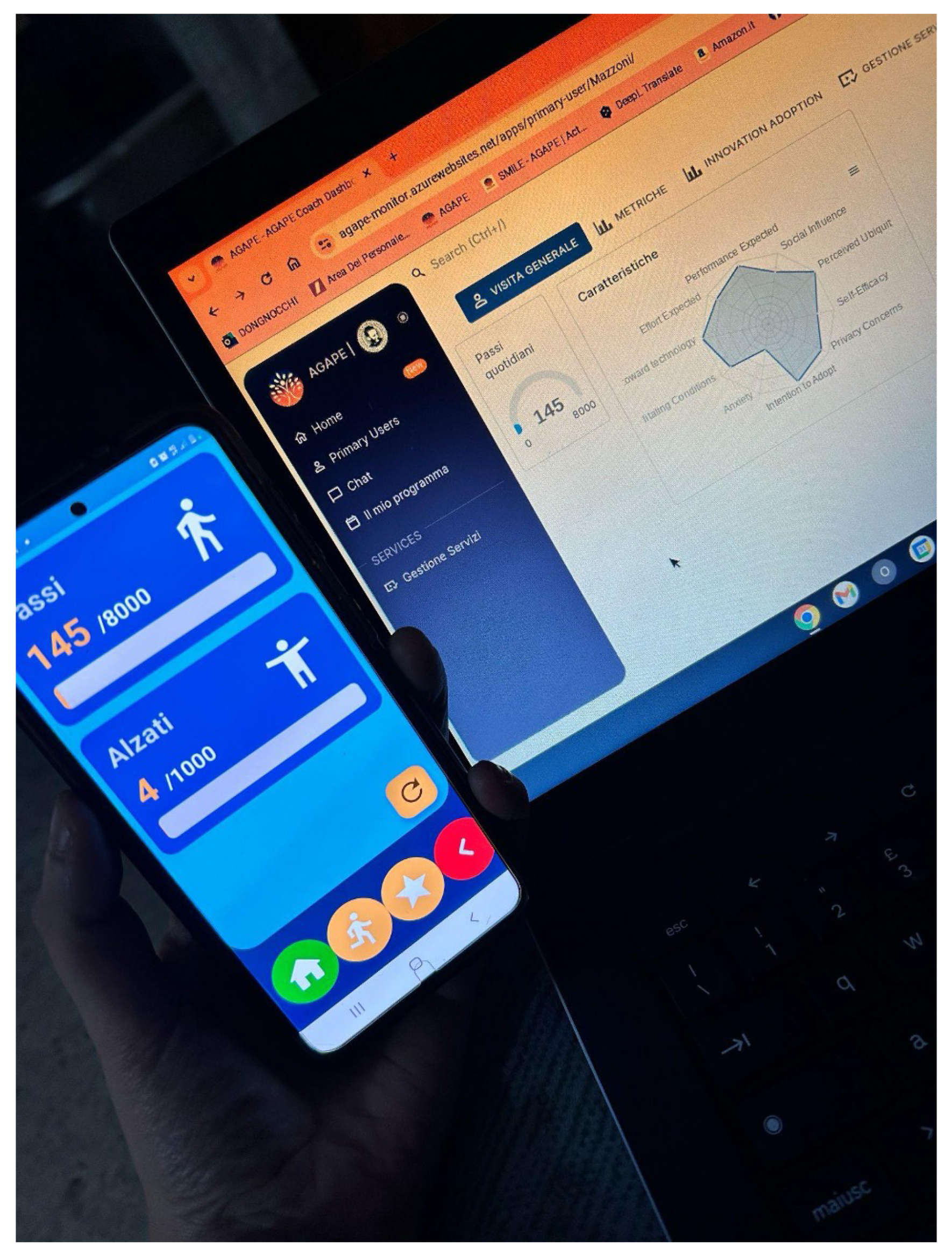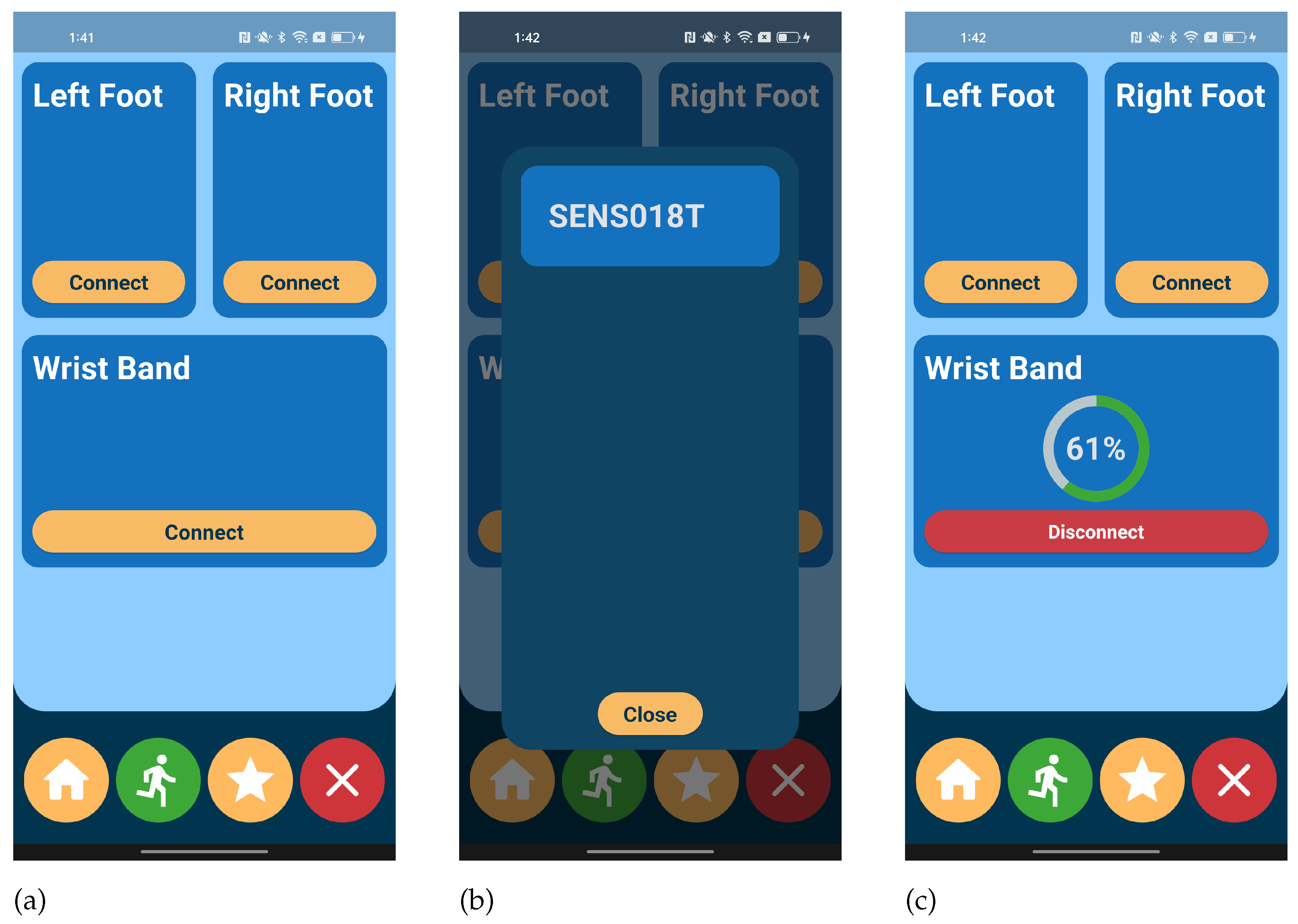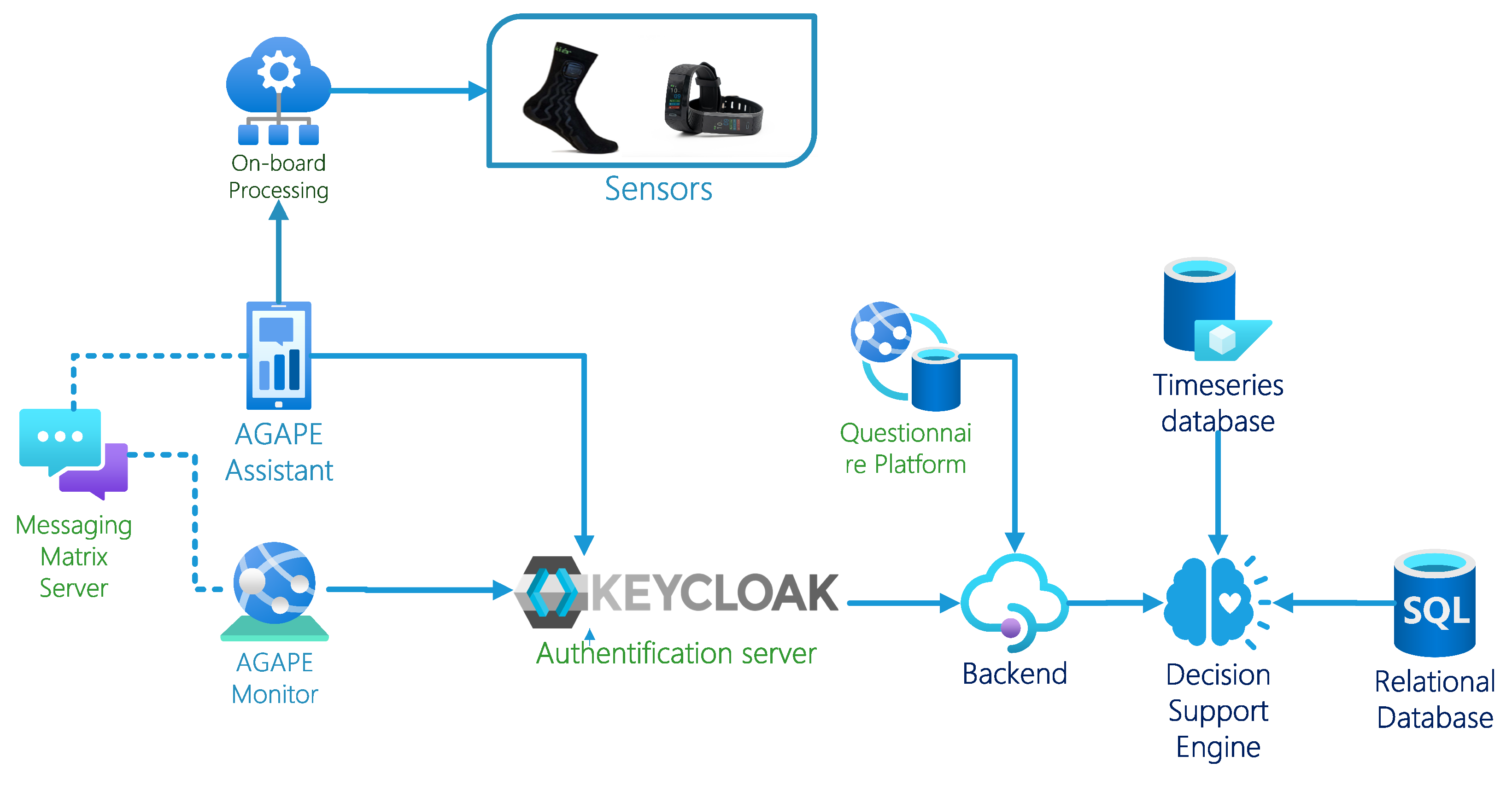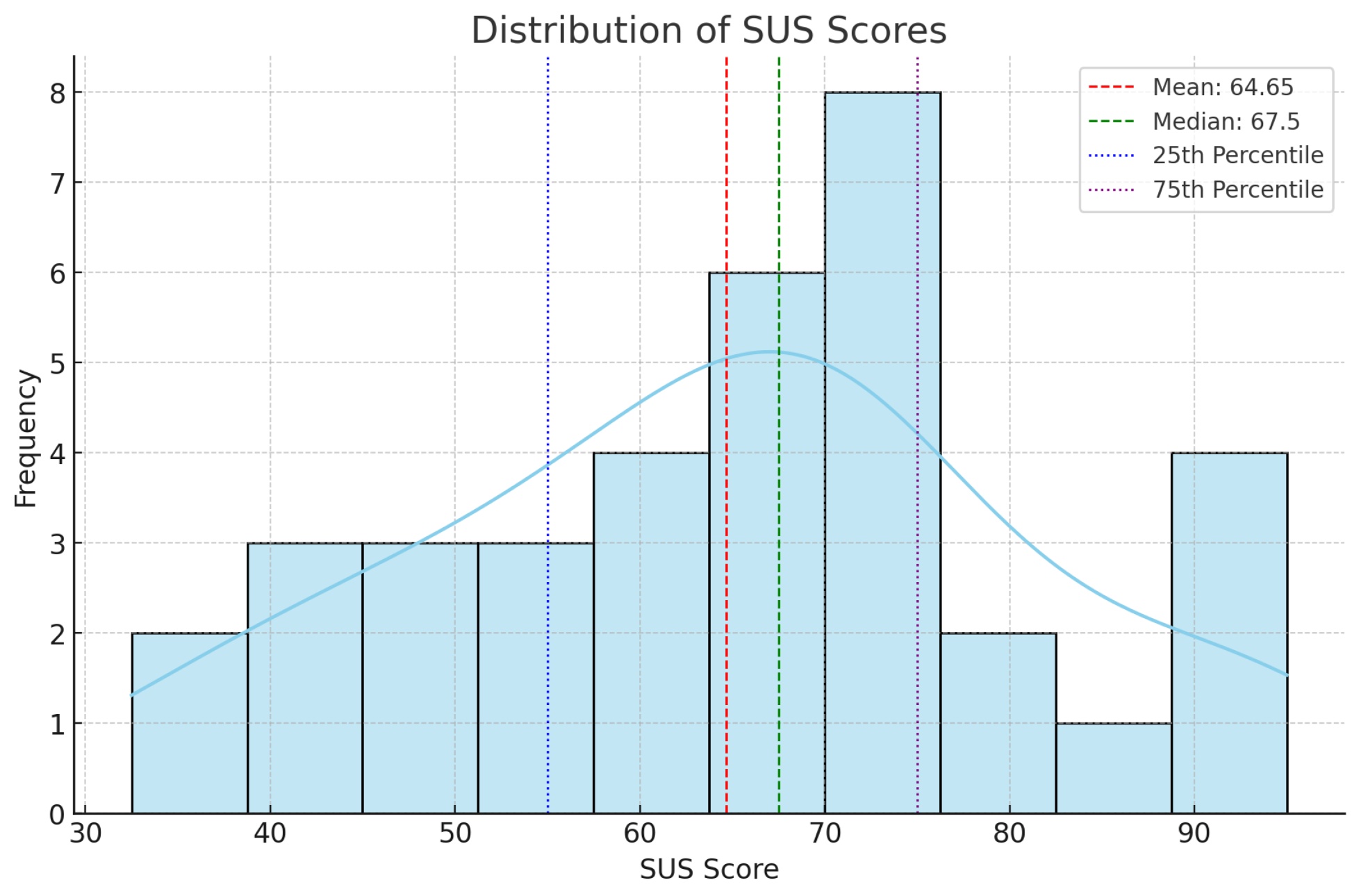Empowering Active and Healthy Ageing: Integrating IoT and Wearable Technologies for Personalised Interventions
Abstract
1. Introduction
2. Materials and Methods
2.1. System Architecture
- Older Adults: The platform is specifically designed to be used by all adults who are older than 65 years [10]. Due to the main objectives of this experimentation (feasibility of home-based use of the solution and usability testing), requiring a most objective feedback from testers, the participants were recruited from able-bodied people, with no severe physical- or cognitive-related disability nor presenting severe mood disorders.
- Formal Caregiver: They are caregivers who have undergone specific training and certification to provide professional care services to those who require assistance [11]. They work in various healthcare settings, such as hospitals, nursing homes, and assisted living facilities.
| Algorithm 1 Calculate Step Count Algorithm |
|
2.2. Workflow and Intervention Delivery
2.3. Data Collected by Wearables
- Steps Count: Measures the number of steps taken daily. These data help in assessing the physical activity levels of the older adults.
- Heart Rate: Monitors heart rate variability to assess cardiovascular health. Continuous heart rate monitoring provides insights into the user’s physical condition and can detect irregularities early.
- Standing Up Frequency: Tracks how often users stand up, indicating their level of mobility and activity. Frequent standing up can be an indicator of higher activity levels and better physical health.
- Interactions with AGAPE Assistant: Logs interactions with the mobile app to monitor engagement and usability. These data are crucial for understanding how often and in what ways users are engaging with the technology.
3. Results
3.1. Wearable Sensor Deployment
3.2. OA Profiling
- Effort Expectancy: Perception of the ease of using technology.
- Performance Expectancy: Expectation of the benefits and effectiveness of using technology.
- Social Influence: Influence of social factors (family, friends or trusted people) on technology adoption decisions.
- Perceived Ubiquity: Perception of the availability and prevalence of technology in daily life.
- Self-Efficacy: Confidence in one’s ability to successfully use technology.
- Privacy Concerns: Concerns about the privacy and security implications of using technology.
- Intention to Adopt: Willingness and readiness to adopt and use technology.
- Anxiety: Feelings of unease or discomfort associated with using technology.
- Facilitating Conditions: Perception of the availability of resources and support to use technology effectively.
- Attitude toward Technology: Overall disposition and feelings toward technology usage.
3.3. AGAPE Assistant
- Simplified Navigation and Large Icons: The AGAPE Assistant features a user-friendly navigation system that includes prominently displayed icons that are easy to identify. This design decision facilitates the navigation of the programme for older folks, particularly those with little digital literacy, by providing them with a user-friendly and intuitive experience. The application features a fixed button located below the content, which has been found to be the most efficient method of navigating in an app for the OA [25].
- High Contrast and Readable Text: The app employs high-contrast colour palettes and utilises large, legible fonts to cater to users with visual impairments. This guarantees that the content is readily legible, hence minimising eye fatigue and enhancing the app’s accessibility.
- Intuitive Layout: The layout of the AGAPE Assistant is designed to be intuitive, with a clear hierarchy of information. Important functions and features are prominently displayed, reducing the cognitive load on users and making it easier for them to find what they need.
- Integration with SeniorPhone App: For users with very low digital literacy, the integration of the SeniorPhone app transforms the traditional Android launcher into a simplified, user-friendly interface. This feature includes large icons, easy navigation, high-contrast colours, and direct access to essential functions like calls, messages and emergency contacts.
3.3.1. Challenges and Adaptations
3.3.2. Usability Assessment of AGAPE Assistant
3.3.3. Technostress Assessment towards Wearables and AGAPE Assistant
3.3.4. Heuristic Evaluation
3.3.5. Short form User Experience Questionnaire (SUEQ)
- Obstructive vs. Supportive: This dimension assesses whether users perceive the technology as hindering or facilitating their tasks and activities. Higher scores indicate a more supportive experience, suggesting that users find the technology helpful rather than obstructive.
- Complicated vs. Easy: This dimension gauges the perceived complexity of the technology. Higher scores indicate that users find the technology easy to use and understand, while lower scores suggest a more complicated interface or system.
- Inefficient vs. Efficient: This dimension evaluates the perceived efficiency of the technology in assisting users with their goals. Higher scores indicate that users perceive the technology as effective and efficient in supporting their activities.
- Confusing vs. Clear: This dimension assesses the clarity and comprehensibility of the technology. Higher scores indicate that users find the technology clear and easy to follow, while lower scores suggest confusion or ambiguity in its usage.
- Boring vs. Exciting: This dimension measures the level of engagement and excitement elicited by the technology. Higher scores suggest that users find the technology engaging and stimulating, while lower scores indicate a lack of interest or excitement.
- Not interesting vs. Interesting: This dimension further evaluates the level of interest sparked by the technology. Higher scores indicate that users find the technology interesting and engaging, while lower scores suggest a lack of interest or novelty.
- Conventional vs. Inventive: This dimension assesses whether users perceive the technology as conventional or innovative. Higher scores suggest that users perceive the technology as innovative and inventive, offering new and creative solutions to their needs.
- Usual vs. Leading Edge: This dimension evaluates whether users perceive the technology as standard or cutting-edge. Higher scores indicate that users perceive the technology as advanced and at the forefront of its field.
3.4. AGAPE Monitor
3.4.1. Real-Time Monitoring and Analysis
3.4.2. Personalised Care Planning
3.4.3. Communication and Social Engagement
3.4.4. Outcome Reporting
3.5. Main Findings
4. State of Art and Discussion
4.1. Related Work
4.2. Discussion
5. Conclusions
Author Contributions
Funding
Institutional Review Board Statement
Informed Consent Statement
Data Availability Statement
Conflicts of Interest
Abbreviations
| OA | Older Adult |
| IoT | Internet of Things |
| AGAPE | Connected Health and Social Engagement Framework for Technology Adoption |
| IMU | Inertial Measurement Unit |
Appendix A



Appendix B
| Date | Steps | Heart Rate (bpm) | Standing Up Frequency | Interactions with AGAPE Assistant |
|---|---|---|---|---|
| 1 April 2023 | 5678 | 72 | 8 | 15 |
| 2 April 2023 | 6210 | 75 | 10 | 18 |
| 3 April 2023 | 4832 | 70 | 7 | 12 |
| 4 April 2023 | 7350 | 78 | 12 | 20 |
| 5 April 2023 | 4980 | 74 | 9 | 16 |
References
- Social Isolation and Loneliness. 2024. Available online: https://www.who.int/teams/social-determinants-of-health/demographic-change-and-healthy-ageing/social-isolation-and-loneliness (accessed on 18 March 2024).
- Ahn, J.; Falk, E.B.; Kang, Y. Relationships between physical activity and loneliness: A systematic review of intervention studies. Curr. Res. Behav. Sci. 2024, 6, 100141. [Google Scholar] [CrossRef]
- Basterfield, L.; Burn, N.L.; Galna, B.; Karoblyte, G.; Weston, K.L. The association between physical fitness, sports club participation and body mass index on health-related quality of life in primary school children from a socioeconomically deprived area of England. Prev. Med. Rep. 2021, 24, 101557. [Google Scholar] [CrossRef]
- Masi, C.M.; Chen, H.Y.; Hawkley, L.C.; Cacioppo, J.T. A meta-analysis of interventions to reduce loneliness. Pers. Soc. Psychol. Rev. 2011, 15, 219–266. [Google Scholar] [CrossRef]
- Karna, E.; Aavikko, L.; Rohner, R.; Gallistl, V.; Pihlainen, K.; Muller, C.; Ehlers, A.; Bevilacqua, R.; Strano, S.; Maranesi, E.; et al. A Multilevel Model of Older Adults’ Appropriation of ICT and Acquisition of Digital Literacy. Int. J. Environ. Res. Public Health 2022, 19, 15714. [Google Scholar] [CrossRef]
- Kristoffersson, A.; Lindén, M. A Systematic Review of Wearable Sensors for Monitoring Physical Activity. Sensors 2022, 22, 573. [Google Scholar] [CrossRef]
- Fang, Y.M.; Chang, C.C. Users’ psychological perception and perceived readability of wearable devices for elderly people. Behav. Inf. Technol. 2016, 35, 225–232. [Google Scholar] [CrossRef]
- Yamatsu, K.; Narazaki, K. Feasibility of the Remote Physical Activity Follow-Up Intervention after the Face-to-Face Program for Healthy Middle-Aged Adults: A Randomized Trial Using ICT and Mobile Technology. Int. J. Environ. Res. Public Health 2022, 19, 4922. [Google Scholar] [CrossRef]
- Kumar, K.; Kumar, A.; Kumar, N.; Mohammed, M.A.; Al-Waisy, A.S.; Jaber, M.M.; Shah, R.; Al-Andoli, M.N. Dimensions of Internet of Things: Technological Taxonomy Architecture Applications and Open Challenges—A Systematic Review. Wirel. Commun. Mob. Comput. 2022, 2022, 9148373. [Google Scholar] [CrossRef]
- Orimo, H. Reviewing the definition of elderly. Nihon Ronen Igakkai Zasshi 2006, 43, 27–34. [Google Scholar] [CrossRef]
- 4 Different Types of Caregivers. Available online: https://www.nautilusshc.com/blog/4-types-of-caregivers (accessed on 20 March 2024).
- Bloc State Management Library. 2024. Available online: https://bloclibrary.dev (accessed on 20 March 2024).
- Yang, X.; Huang, B. An accurate step detection algorithm using unconstrained smartphones. In Proceedings of the 27th Chinese Control and Decision Conference (2015 CCDC), Qingdao, China, 23–25 May 2015; pp. 5682–5687. [Google Scholar] [CrossRef]
- Nugent, C.; Cleland, I.; Nugent, L.; Estevez, M.E.; Lendinez, A.M.; Craig, D.; Agnoloni, F.; Tamburini, E. Using Generative AI to Assist with Technology Adoption Assessment. In International Conference on Ubiquitous Computing and Ambient Intelligence; Springer: Cham, Switzerland, 2023; pp. 202–207. [Google Scholar]
- Davis, F.D. Perceived usefulness, perceived ease of use, and user acceptance of information technology. MIS Q. 1989, 13, 319–340. [Google Scholar] [CrossRef]
- Venkatesh, V.; Morris, M.G.; Davis, G.B.; Davis, F.D. User acceptance of information technology: Toward a unified view. MIS Q. 2003, 13, 425–478. [Google Scholar] [CrossRef]
- Alaiad, A.; Alsharo, M.; Alnsour, Y. The determinants of m-health adoption in developing countries: An empirical investigation. Appl. Clin. Inform. 2019, 10, 820–840. [Google Scholar] [CrossRef]
- Liu, Y.; Lu, X.; Zhao, G.; Li, C.; Shi, J. Adoption of mobile health services using the unified theory of acceptance and use of technology model: Self-efficacy and privacy concerns. Front. Psychol. 2022, 13, 944976. [Google Scholar] [CrossRef]
- Brooke, J. SUS: A quick and dirty usability scale. Usability Eval. Ind. 1995, 189, 4–7. [Google Scholar]
- Ragu-Nathan, T.S.; Tarafdar, M.; Ragu-Nathan, B.S.; Tu, Q. The Consequences of Technostress for End Users in Organizations: Conceptual Development and Empirical Validation. Inf. Syst. Res. 2008, 19, 417–433. [Google Scholar] [CrossRef]
- Schrepp, M.; Hinderks, A.; Thomaschewski, J. Applying the User Experience Questionnaire (UEQ) in Different Evaluation Scenarios. In Design, User Experience, and Usability. Theories, Methods, and Tools for Designing the User Experience; Marcus, A., Ed.; Springer: Cham, Switzerland, 2014; pp. 383–392. [Google Scholar]
- Oh, S.S.; Kim, K.A.; Kim, M.; Oh, J.; Chu, S.H.; Choi, J. Measurement of digital literacy among older adults: Systematic review. J. Med. Internet Res. 2021, 23, e26145. [Google Scholar] [CrossRef] [PubMed]
- Xie, L.; Zhang, S.; Xin, M.; Zhu, M.; Lu, W.; Mo, P.K.H. Electronic health literacy and health-related outcomes among older adults: A systematic review. Prev. Med. 2022, 157, 106997. [Google Scholar] [CrossRef]
- Wilson, J.; Heinsch, M.; Betts, D.; Booth, D.; Kay-Lambkin, F. Barriers and facilitators to the use of e-health by older adults: A scoping review. BMC Public Health 2021, 21, 1556. [Google Scholar] [CrossRef]
- Rivas, A.; Antoun, C.; Feuer, S.; Mathew, T.; Nichols, E.; Olmsted-Hawala, E.; Wang, L. Comparison of Three Navigation Button Designs in Mobile Survey for Older Adults. Surv. Pract. 2022, 15, 1–14. [Google Scholar] [CrossRef]
- Nielsen, J.; Molich, R. Heuristic evaluation of user interfaces. In Proceedings of the CHI ’90: Conference on Human Factors in Computing, Seattle, WA, USA, 1–5 April 1990; pp. 249–256. [Google Scholar] [CrossRef]
- Blackman, S.; Matlo, C.; Bobrovitskiy, C.; Waldoch, A.; Fang, M.L.; Jackson, P.; Mihailidis, A.; Nygård, L.; Astell, A.; Sixsmith, A. Ambient Assisted Living Technologies for Aging Well: A Scoping Review. J. Intell. Syst. 2016, 25, 55–69. [Google Scholar] [CrossRef]
- Alexandru, A.; Ianculescu, M. Enabling Assistive Technologies to Shape the Future of the Intensive Senior-Centred Care: A Case Study Approach. Stud. Inform. Control 2017, 26, 343–352. [Google Scholar] [CrossRef]
- Nunes, F.; Verdezoto, N.; Fitzpatrick, G.; Kyng, M.; Grönvall, E.; Storni, C. Self-Care Technologies in HCI. ACM Trans. Comput.-Hum. Interact. 2015, 22, 1–45. [Google Scholar] [CrossRef]
- Iranpak, S.; Shahbahrami, A.; Shakeri, H. Remote patient monitoring and classifying using the internet of things platform combined with cloud computing. J. Big Data 2021, 8, 120. [Google Scholar] [CrossRef]
- Liu, Q.; Sun, S.; Yuan, X.; Zhang, Y. Ambient backscatter communication-based smart 5G IoT network. EURASIP J. Wirel. Commun. Netw. 2021, 2021, 34. [Google Scholar] [CrossRef]
- Malwade, S.; Abdul, S.S.; Uddin, M.; Nursetyo, A.A.; Fernandez-Luque, L.; Zhu, X.; Cilliers, L.; Wong, C.P.; Bamidis, P.; Li, Y.C. Mobile and wearable technologies in healthcare for the ageing population. Comput. Methods Programs Biomed. 2018, 161, 233–237. [Google Scholar] [CrossRef]
- Awadalla, M.; Kausar, F.; Ahshan, R. Developing an IoT Platform for the Elderly Health Care. Int. J. Adv. Comput. Sci. Appl. 2021, 12. [Google Scholar] [CrossRef]
- Stavrotheodoros, S.; Kaklanis, N.; Votis, K.; Tzovaras, D. A Smart-Home IoT Infrastructure for the Support of Independent Living of Older Adults. In IFIP Advances in Information and Communication Technology; Springer: Cham, Switzerland, 2018; pp. 238–249. [Google Scholar] [CrossRef]
- Lorusso, L.; Mosmondor, M.; Grguric, A.; Toccafondi, L.; D’Onofrio, G.; Russo, S.; Lampe, J.; Pihl, T.; Mayer, N.; Vignani, G.; et al. Design and Evaluation of Personalized Services to Foster Active Aging: The Experience of Technology Pre-Validation in Italian Pilots. Sensors 2023, 23, 797. [Google Scholar] [CrossRef]
- Baig, M.M.; Afifi, S.; GholamHosseini, H.; Mirza, F. A Systematic Review of Wearable Sensors and IoT-Based Monitoring Applications for Older Adults - a Focus on Ageing Population and Independent Living. J. Med. Syst. 2019, 43, 233. [Google Scholar] [CrossRef] [PubMed]
- Rojo-Perez, F.; Rodriguez-Rodriguez, V.; Molina-Martinez, M.A.; Fernandez-Mayoralas, G.; Sanchez-Gonzalez, D.; Rojo-Abuin, J.M.; Ayala, A.; Rodriguez-Blazquez, C.; Calderon-Larranaga, A.; Ribeiro, O.; et al. Active ageing profiles among older adults in Spain: A Multivariate analysis based on SHARE study. PLoS ONE 2022, 17, e0272549. [Google Scholar] [CrossRef]
- Michele, J.; Guillaume, M.; Alain, T.; Nathalie, B.; Claude, F.; Kamel, G. Social and leisure activity profiles and well-being among the older adults: A longitudinal study. Aging Ment. Health 2019, 23, 77–83. [Google Scholar] [CrossRef]
- Morrow-Howell, N.; Putnam, M.; Lee, Y.S.; Greenfield, J.C.; Inoue, M.; Chen, H. An investigation of activity profiles of older adults. J. Gerontol. B Psychol. Sci. Soc. Sci. 2014, 69, 809–821. [Google Scholar] [CrossRef] [PubMed]
- Cristiano, A.; Musteata, S.; De Silvestri, S.; Bellandi, V.; Ceravolo, P.; Cesari, M.; Azzolino, D.; Sanna, A.; Trojaniello, D. Older Adults’ and Clinicians’ Perspectives on a Smart Health Platform for the Aging Population: Design and Evaluation Study. JMIR Aging 2022, 5, e29623. [Google Scholar] [CrossRef] [PubMed]
- D’Onofrio, G.; Fiorini, L.; Toccafondi, L.; Rovini, E.; Russo, S.; Ciccone, F.; Giuliani, F.; Sancarlo, D.; Cavallo, F. Pilots for Healthy and Active Ageing (PHArA-ON) Project: Definition of New Technological Solutions for Older People in Italian Pilot Sites Based on Elicited User Needs. Sensors 2021, 22, 163. [Google Scholar] [CrossRef]
- Liu, C.H.; Tu, J.F. Development of an IoT-Based Health Promotion System for Seniors. Sustainability 2020, 12, 8946. [Google Scholar] [CrossRef]
- Nebeker, C.; Zlatar, Z.Z. Learning From Older Adults to Promote Independent Physical Activity Using Mobile Health (mHealth). Front. Public Health 2021, 9, 703910. [Google Scholar] [CrossRef]
- Spinsante, S.; Poli, A.; Mongay Batalla, J.; Krawiec, P.; Dobre, C.; Bǎjenaru, L.; Mavromoustakis, C.X.; Costantinou, C.S.; Molan, G.; Herghelegiu, A.M.; et al. Clinically-validated technologies for assisted living. J. Ambient. Intell. Humaniz. Comput. 2023, 14, 2095–2116. [Google Scholar] [CrossRef]
- Lin, S.H. Adoption of Mobile and Wearable Technology for Older Adults’ Physical Activity: A Preliminary Model. J. Consum. Health Internet 2023, 27, 139–155. [Google Scholar] [CrossRef]
- Chaparro, J.D.; Ruiz, J.F.B.; Romero, M.J.S.; Peño, C.B.; Irurtia, L.U.; Perea, M.G.; Garcia, X.D.T.; Molina, F.J.V.; Grigoleit, S.; Lopez, J.C. The SHAPES Smart Mirror Approach for Independent Living, Healthy and Active Ageing. Sensors 2021, 21, 7938. [Google Scholar] [CrossRef]
- Hvalič-Touzery, S.; Šetinc, M.; Dolničar, V. Benefits of a Wearable Activity Tracker with Safety Features for Older Adults: An Intervention Study. Int. J. Environ. Res. Public Health 2022, 19, 15723. [Google Scholar] [CrossRef]
- Talukder, M.S.; Laato, S.; Islam, A.K.M.N.; Bao, Y. Continued use intention of wearable health technologies among the elderly: An enablers and inhibitors perspective. Int. Res. 2021, 31, 1611–1640. [Google Scholar] [CrossRef]
- Index—FHIR v5.0.0. 2024. Available online: http://hl7.org/fhir (accessed on 17 May 2024).




| Profile Name | Description | Number of OA |
|---|---|---|
| A1 | Low digital literacy and unfamiliar with technological tools like mobile application and wearables. These OAs might exhibit some suspicion and fear towards new technology. | 15 |
| A2 | OAs already own a smartphone and have basic digital skills. For example, they can emit and receive phone calls on full autonomy. These OAs might exhibit some concerns regarding the integration of wearables and new technologies for health monitoring. | 50 |
| B1 | Moderate to high digital skills and daily use of their smartphones. They usually have positive attitudes towards the use of the new technology and perceives these technologies as a game-changer for improving their health conditions. | 43 |
| B2 | Very high digital literacy and have already integrated wearables or other health monitoring devices in their lifestyle. They can operate most technological tools and even perform some advanced procedures on full autonomy. For example, resetting and reconnecting a wearable. | 4 |
| Solution | Health Monitoring | Activity Tracking | Social Interaction | Personalization | User Profiling |
|---|---|---|---|---|---|
| Iranpak et al. [30] | X | ||||
| Liu et al. [31] | X | X | |||
| Awadalla et al. [33] | X | X | |||
| Stavrotheodoros et al. [34] | X | ||||
| Lorusso et al. [35] | X | X | |||
| Rojo-Perez et al. [37] | X | X | |||
| Michèle et al. [38] | X | X | X | ||
| Morrow-Howell et al. [39] | X | X | X | ||
| Cristiano et al. [40] | X | X | |||
| D’Onofrio et al. [41] | X | X | X | ||
| Liu et al. [42] | X | X | X | ||
| Nebeker et al. [43] | X | X | |||
| Spinsante et al. [44] | X | X | X | X | X |
| Lin et al. [45] | X | X | |||
| Chaparro et al. [46] | X | X | |||
| Hvalic-Touzery et al. [47] | X | X | |||
| Talukder et al. [48] | X | X | X | ||
| AGAPE Platform | X | X | X | X | X |
Disclaimer/Publisher’s Note: The statements, opinions and data contained in all publications are solely those of the individual author(s) and contributor(s) and not of MDPI and/or the editor(s). MDPI and/or the editor(s) disclaim responsibility for any injury to people or property resulting from any ideas, methods, instructions or products referred to in the content. |
© 2024 by the authors. Licensee MDPI, Basel, Switzerland. This article is an open access article distributed under the terms and conditions of the Creative Commons Attribution (CC BY) license (https://creativecommons.org/licenses/by/4.0/).
Share and Cite
Joymangul, J.S.; Ciobanu, I.; Agnoloni, F.; Lampe, J.; Pedrini, C.; Pinto, A.; Franceschini, B.; Nicolas, D.; Tamburini, E.; Cecchi, F.; et al. Empowering Active and Healthy Ageing: Integrating IoT and Wearable Technologies for Personalised Interventions. Appl. Sci. 2024, 14, 4789. https://doi.org/10.3390/app14114789
Joymangul JS, Ciobanu I, Agnoloni F, Lampe J, Pedrini C, Pinto A, Franceschini B, Nicolas D, Tamburini E, Cecchi F, et al. Empowering Active and Healthy Ageing: Integrating IoT and Wearable Technologies for Personalised Interventions. Applied Sciences. 2024; 14(11):4789. https://doi.org/10.3390/app14114789
Chicago/Turabian StyleJoymangul, Jensen Selwyn, Ileana Ciobanu, Francesco Agnoloni, Jure Lampe, Chiara Pedrini, Angela Pinto, Bruna Franceschini, Damien Nicolas, Elena Tamburini, Francesca Cecchi, and et al. 2024. "Empowering Active and Healthy Ageing: Integrating IoT and Wearable Technologies for Personalised Interventions" Applied Sciences 14, no. 11: 4789. https://doi.org/10.3390/app14114789
APA StyleJoymangul, J. S., Ciobanu, I., Agnoloni, F., Lampe, J., Pedrini, C., Pinto, A., Franceschini, B., Nicolas, D., Tamburini, E., Cecchi, F., Berteanu, M., & Khadraoui, D. (2024). Empowering Active and Healthy Ageing: Integrating IoT and Wearable Technologies for Personalised Interventions. Applied Sciences, 14(11), 4789. https://doi.org/10.3390/app14114789









